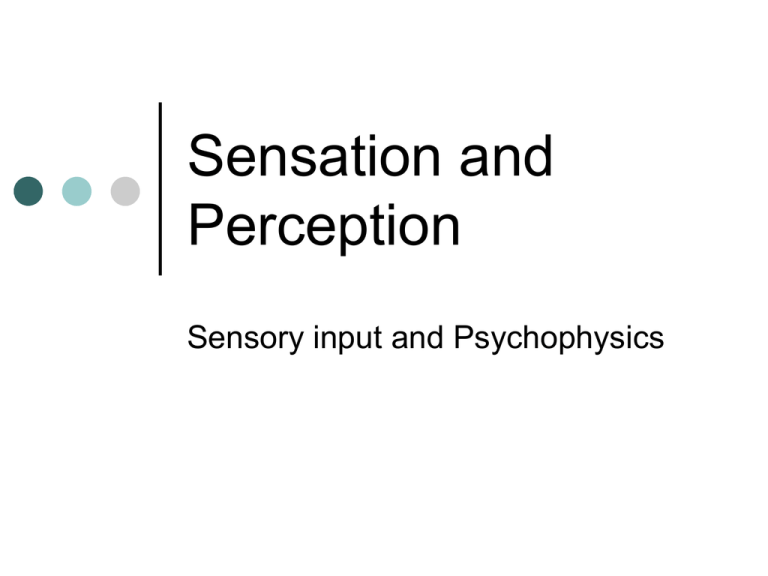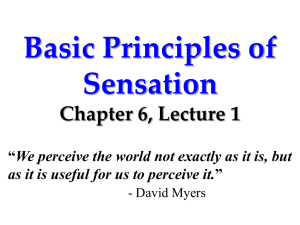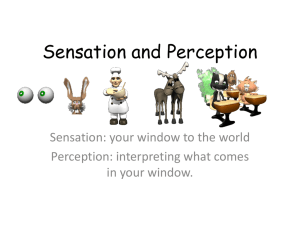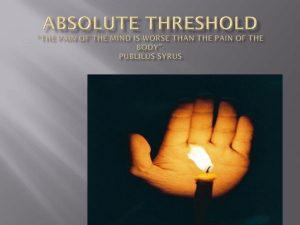Sensation and Perception
advertisement

Sensation and Perception Sensory input and Psychophysics Sensation and Perception What do you hear? What do you see? What do you taste? What do you smell? What do you feel? (not emotion) What conclusions can you draw from these answers? Sensation Starts with a stimulus (any aspect of change in our environment to which we respond) Can be measured in size, duration, intensity and wavelength Occurs anytime a stimulus activates a receptor Sensory Receptor Living cell that responds to certain type of energy Often located in sense organs Specialized structure that collects energy particularly well… (eye, ear, etc) Detect physical changes in energy such as heat, light, sound, and physical pressure Eye- notes changes in light Ear- notes changes in sound Skin- notes changes in heat and pressure Perception Organization of sensory information into a meaningful experience Comes from a combination of sensations and past experiences Translating the stimulus into the language of the nervous system (neural impulse) comprehending the basic components of the stimulus, size, shape, color Organizing the components into an understandable explanation Psychophysics The interaction between the physical world (stimuli) and the psychological world (internal experience) What is the relationship between color and wavelength? How does changing a light’s intensity affect your perception of it’s brightness? Threshold How much energy is required for someone to hear a sound, or see a light? How much of a scent must be in a room for someone to smell it? How much pressure must be put on the skin for someone to feel it? Is it the same for everyone? How strong must a stimulus be in order for detection? Threshold- dividing line Not exact Absolute threshold- point at which a very weak stimulus can be detected 50% of the time Difference threshold- smallest change a person can detect 50% of the time. (JND) just noticeable difference Absolute threshold for 5 senses Vision- seeing a candle flame 30 miles away on a clear night Absolute threshold Hearing- watch ticking 20 feet away Absolute Threshold Tasting- 1 teaspoon of sugar dissolved in 2 gallons of water Absolute threshold Smell- 1 drop of perfume in a 3 room house Absolute threshold Touch- feeling a bee’s wings falling a distance of 1 centimeter onto your cheek Weber’s Law- related to the Just Noticeable Difference (also known as the difference threshold), which is the minimum difference in stimulation that a person can detect 50 percent of the time. The larger the magnitude of the stimulus, the larger the JND 25 watt light bulb / 50 watt light bulb very different 175 watt light bulb / 200 watt light bulb hard to notice Weber’s Law The JND increases in direct proportion to the intensity of the stimulus. Often not true when stimuli approach extreme values. Sensory adaptation Our senses are tuned to change and respond to increases and decreases in stimuli, or new events rather than constant stimulation. We adapt to change/deviation in stimulation Movie theater Clothes on body Signal Detection theory- how good are you at recognizing stimuli? Study of people’s tendencies to make correct judgments in detecting the presence of stimuli Recognizing stimuli against a competing background of stimuli Individuals vary based on situation Radar operator Signal Detection theory Pre-attentive process- getting info automatically and simultaneously when presented with stimuli Attentive process- paying attention to only one of the stimuli at a time when presented with multiple stimuli All tasks require attention, but some require more than others. P.212-213





